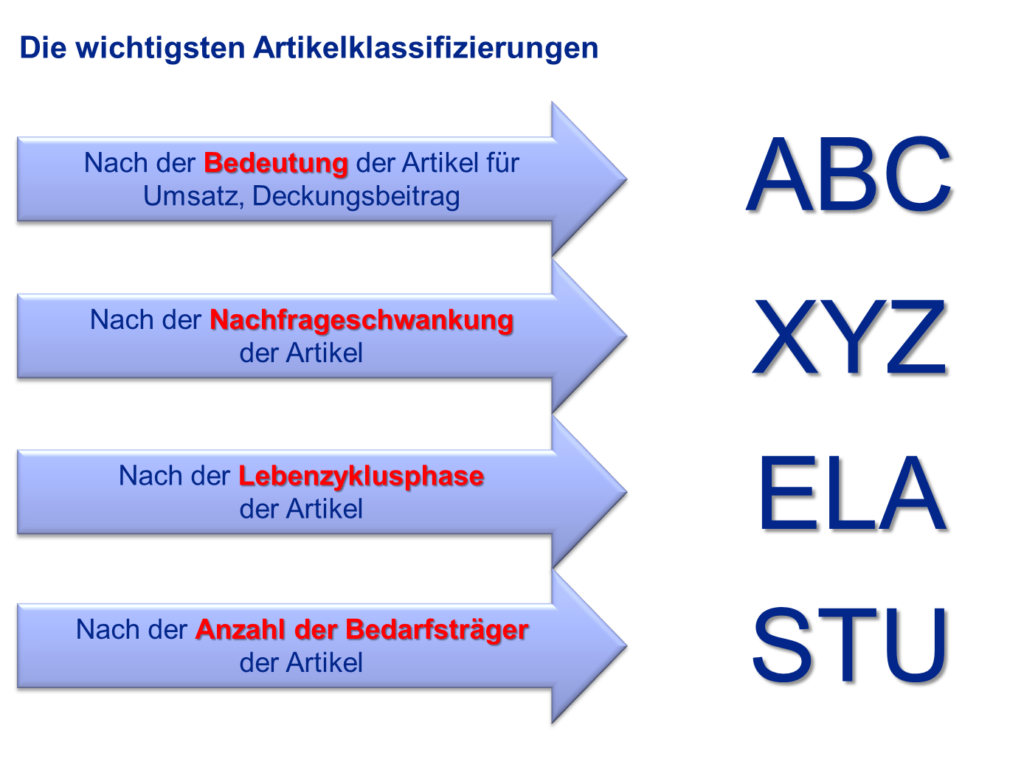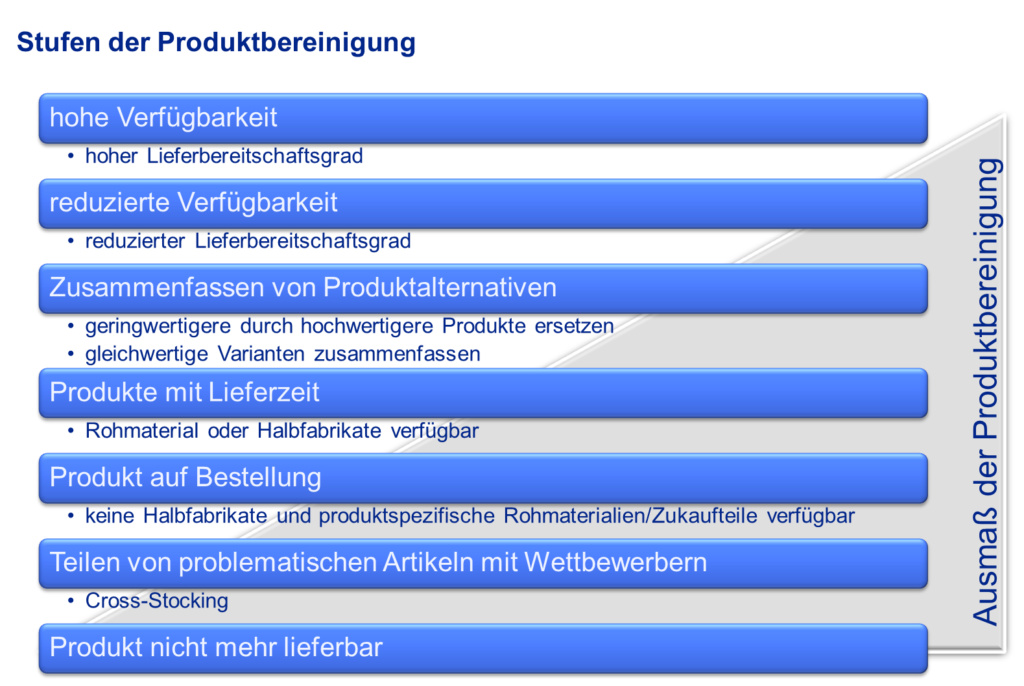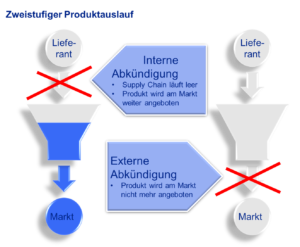Part 2: Why “better” is often better than “a lot”
Last week, we showed you some initial steps in the first part of our best practice article on product portfolio management:
Among other things, we have explained to you why a “CZ explosion” occurs in most companies at some point and why regular monitoring of the four most important inventory dimensions ABC, XYZ, STU and ELA can help prevent this.
In Part 1, we also talked about the exotic products in our portfolio. Exotic products are sold in small quantities and therefore have low stock throughputs. The vast majority of exotic products are therefore in extremely irregular demand and therefore fall into the CZ and CZ2 classes of the product portfolio. If you look at the composition of a product portfolio over the years, you will see that the number of items does not increase evenly across all portfolio areas, but rather increases primarily in the CZ and CZ2 areas.
This is not surprising, as every new product begins its life as a CZ2 or at least a CZ item. If it is successful on the market, it will develop into an AX article in the best case, but at least move out of the CZ/CZ2 corner. Unfortunately, the natural laws of the market mean that very few articles are successful. The majority of all articles never find their way from the depths of the product portfolio to the heights of market success. As a result, the product portfolio is enriched with articles in the CZ/CZ2 area to a disproportionately high degree.
We already talked about the problems involved in calculating the costs and therefore the price of an item at the beginning. The calculation problems tend to lead to CZ and CZ2 articles being underestimated in their actual costs and AX articles being overestimated in theirs. This calculation distortion can be easily visualized using the example of sales. Many of us are familiar with the star salespeople in our companies who are responsible for important key accounts or who sell dominant products. In addition to these few stars, a large number of hard-working salespeople often fight on small-scale product and customer fronts. While the supposed stars hardly sell anything but have to make a note of what quantities their customers want, the rest of the crowd make a real effort to bring the famous “sour beer” to the people.
All too often, the total costs of distribution are only allocated according to “carrying capacity”, which means nothing other than that they are added to the product costing in proportion to sales. For example, 20% of the best-selling items quickly account for 80% of the total distribution costs.
What happens as a result is something we see time and time again in business life and in practically all sectors: If there are too many CZ and CZ2 articles, the AX articles have to be sold at too high a price. This enables competitors to break into the AX article segment with cheaper offers.
The food discounters in Germany provide the classic example of this development. Over the years, they have taken market share from traditional retailers. They concentrated on just a few articles: the AAXX articles of daily life. This enabled them to structure their value chain cost-effectively and buy in large quantities with corresponding discounts. Traditional retailers offer a wide range of other products, including many truly exotic items, in addition to the bestsellers on the discount market and, in order to finance this, have to sell their bestsellers at a higher average price than the discounters.

Do you think this is a special case in retail? If we look at developments in the German or Swiss machine tool industry, we can see a similar effect. In the sixties and seventies of the last century, the machine tool industry was proud of the customized special solutions it was able to offer thanks to its engineering advantage over the emerging Japanese competition. Which customer would want “butter-soft” lathes that bent every time a large part was machined and could only maintain small manufacturing tolerances?
However, the buttery-soft Japanese lathes were cheap because the manufacturers concentrated on standard machines – probably more due to engineering deficits than market strategy considerations. Perhaps not so surprisingly, many customers needed these butter-soft machines. They were quite economical for small, less demanding parts. Japanese manufacturers opened up the world market by leveraging such unexciting bread-and-butter machines. The Central European machine tool industry only regained market share when its engineering expertise enabled it to build its products according to modular principles and thus closely combine standard and customer-specific solutions.
The AX portfolio is the typical point of attack where new competitors break into existing markets. For this reason, best practice building block 3 is :
Successful companies keep their portfolio raft in balance.
If a company wants to go down the path of streamlining its product portfolio, it must not be afraid of the spectre of product range constraints, as Basic Principle 4 states: Product range constraints are the blinkers of product policy.
If one economic party forces another to purchase or supply not only the products requested by the other party, but a more or less defined broader range of products, this is referred to as assortment coercion.
Product range constraints are found on the supplier side, primarily in the business-to-business sector. Compulsory assortment can be exercised by a supplier who forces its customers to purchase a complete assortment or by customers who demand that a supplier also provide rare and irregularly required articles in addition to the articles they require regularly and in large quantities.
A product range demanded by the customer is rarely contractually fixed, but is understood by the sales department as a service or is provided in anticipatory obedience.
From the point of view of product portfolio management, the customer’s product range constraints play an unfavorable role. Genuine assortment constraints imposed by the market or explicit customers must be handled with extreme caution, yet we regularly find that assortment constraints are one of the most overrated criteria in product portfolio management. This sounds very daring for a logistics specialist. However, product range constraints are not a nebulous matter, but can be statistically recorded and scrutinized:
- When product A was purchased, how often was product B also purchased?
- If product B is often purchased with product A,
- Couldn’t product C be offered instead?
- Is it then a compulsory connection for the customer or just a collective order?
As important as product range constraints can be in individual cases, they are unimportant in many other cases of product range policy. If a company were to design its product portfolio solely according to the supposed product range constraints of its customers, all of the company’s problems would dissolve in insolvency in the medium term.
The product portfolio is determined by a whole range of other criteria, both strategic and economic. Ultimately, money must be earned with the current product portfolio, which is why no one can close their eyes to the contribution margins of the individual products. Economic constraints continue to be exerted by the safety stocks required to keep a product at the required level of readiness for delivery. The residual stocks that would remain if a product were to be disposed of in the short term must also be taken into account when streamlining the product portfolio.
It is more difficult to part with items with a high share of sales than with items with a low share of sales, even if they only have low contribution margins. This is not least because they can be important for the perception of a company on the market and also hold great earnings potential if contribution margins can be improved.
From a strategic point of view, it is important to ensure that the articles are distributed over the entire product life cycle: at least in the case of high-margin articles, it is better to have a left skew (more articles for the new product launches) than a right skew (more articles for the discontinued products).
For this reason, we can state best practice building block 4: Six central criteria determine whether an item remains in the product range. Only one of these is the assortment constraint.
Anyone who has ever been involved in discussions about streamlining a stock manufacturer’s product range knows how intensely the sales department in particular defends the exotic products in the product portfolio. The easiest way to do this is to link the launch of new products to the disposal of old ones. A sales organization that earns money from every fish it catches and does not have to pay for the fishing itself is behaving completely consistently when it resists streamlining its product portfolio. For this reason, the aspects of reintroduction and removal are always seen in relation to each other.
Another key reason for the hesitant behavior of the sales department can be found in Basic Principle 5: Many companies make decisions when streamlining products, like in the Roman circus: thumbs up or thumbs down.
If sorting out products is only a matter of either/or, this is not only painful from a sales point of view, but can also be very painful for logistics. This is always the case when a product to be discontinued still has a lot of remaining stock or open deliveries from suppliers, which would leave the supply chain stranded.
However, the world of product portfolio management cannot simply be seen in black and white – especially not from the perspective of logistics and supply chain management. Fine gradations are possible between a brightly shining article with high delivery readiness and a darkly disappearing article that can no longer be delivered. For example, you can first consider withdrawing the delivery readiness level of an item. The item is therefore still available, but it will be more common for customers to have to wait for the item to be delivered. In our experience from numerous projects, customers accept this when it comes to exotic items that are either only offered by a specific supplier or are difficult to obtain from all relevant suppliers.

The strategy of providing products with a delivery time and keeping only the necessary raw materials and semi-finished products in stock goes one step further. The required article can then be produced from these as required. Even with this strategy, the affected item will be available in parts from stock, as in most cases it is produced in batches and not in individual pieces. The batch quantities in excess of customer requirements are then kept in stock as finished goods. In various cases, our simulations have shown that an immediate delivery capability of 50% can still be achieved.
If you do not keep semi-finished products, specific raw materials or purchased parts in stock in order to be able to manufacture the end product, you end up with a “product to order”, where delivery times can be considerably long and care must be taken to ensure that the sales price also covers the production costs.
Only the last step consists of no longer supplying a product at all.
In many cases, it is not even necessary to think about the gradual elimination of an item if you have previously considered the aggregation or substitution of items. It can therefore be significantly more cost-effective to dispense with various lower-value variants of a product in favor of a higher-value variant that replaces them all. The higher material and production costs can be more than compensated for by the savings in inventory and disposal costs. You are aiming in the same direction if you combine several equivalent variants into one variant, e.g. by reducing the number of product sizes on offer.
Cross-stocking can be a sometimes bold, but occasionally very successful strategy. In cross-stocking, two competitors share the trouble with CZ and CZ2 parts by dividing up the corresponding product portfolio and supplying each other.
As you can see, streamlining the product portfolio can be a colorful affair with exciting new possibilities. That’s why we consider best practice building block no. 5: Successful companies maintain their product portfolio regularly and consistently, but in a differentiated way.
When maintaining your product portfolio, you don’t always have to find the right answers yourself if you follow Basic Principle 6: Customers react sensitively to price differentiation.
Everyone involved in sales is familiar with haggling over the price of a product or service: the saleswoman in the fashion boutique as well as the head of sales at a large corporation. Often, regardless of the value a product or service has for a customer, customers and buyers try to push the price down. The extreme price sensitivity of the market can sometimes be cleverly used to streamline the product range.
As a first step, you can discount preferred variants and thus reduce demand for unpopular variants. In the short term, this may result in a loss of earnings, but in the medium term it may lead to increased earnings due to volume effects.
Customers who have stuck with their original product variants despite the price differentiation are either less price-sensitive or need “their” core product variants for certain reasons.
In a second step, you should now consider making the unpopular product variants more expensive. This will attract a further proportion of customers to the cheaper variants and thus reinforce the volume effects there. This step will prompt some customers to switch to you as their supplier. However, the customers who remain with their traditional product variants will not be happy, but will be forced to pay the higher prices and thus better contribution margins.
The fewer customers you have to deal with, the more careful you need to be with step 2 of this strategy. We will come back to this aspect later. Nevertheless, many companies apply best practice building block 6: Successful companies involve their customers in product range streamlining by means of price differentiation.
Whichever way you choose to streamline your product portfolio, basic principle 7 must be observed so that a product streamlining process can be carried out as cost-effectively as possible from a logistics perspective: A supply chain needs time to run empty in order to keep the costs of remaining stock low.
Remaining stocks are a regular nuisance in logistics. They always arise when production volumes can no longer be sold on the market and there are many different reasons for this:
Excessively high demand forecasts for new or live products lead to quantities that can either never be sold again, exceed their expiration date or can no longer be used as spare parts due to technical changes or can only be used in customer service.
Another, but often neglected, cause of residual stock and disposal costs results from product streamlining. For companies that produce for an anonymous market, a product phase-out should always take place in two stages. In stage 1, the product is discontinued “internally”. Logistically, this means that the sourcing of the product itself or product-specific raw materials, materials and semi-finished products is stopped. The value creation pipeline is allowed to run as empty as possible before the product is “externally” discontinued in stage 2. Once the product has been withdrawn from the market and can no longer be found in the catalog or on websites, the remaining stocks can only be used for spare parts and warranty purposes at the various stages of the value chain.

For this reason, best practice building block 7 is: For companies that manufacture for an anonymous market, product discontinuation always takes place in two stages: internal discontinuation and external discontinuation.
In anonymous markets, you may know your customers statistically, but not personally. By contrast, in familiar markets, especially in the capital goods sector, the customer must be seen as an individual contractual partner. Companies that do not take this into account quickly learn Basic Principle 8: Customers react negatively to product streamlining if they are not informed and do not have time to react.
Nobody wants to voluntarily give up products they have become accustomed to. Many customers who ask you and thus practically request approval for a product adjustment will initially be reluctant. For this reason, it should be clear in advance of the customer information which products and variants you want to eliminate from your product portfolio. The sales department can then inform customers about alternative products, preferably from their own company, of course. If there is no alternative product in your own company, but you know of a suitable alternative product from a competitor, you should point this out to the customer. If he needs the product, he will find your competitor anyway. If you point him in the right direction right away, you improve your cards a little; especially if the customer continues to stay with you with other products. Giving customers a deadline for final orders should be a matter of course.
Particularly customer-oriented companies sometimes go one step further and support good customers with special services as part of product streamlining. For example, customers can be granted special conditions for products they continue to purchase or customers can be supported in making the necessary process adjustments to an alternative product or a new raw material. The assumption of development or quality testing costs for alternative products may also be an option.
This strategy can be summarized in best practice module 8: The articles affected by an assortment adjustment in the b2b area are to be determined independently of the customers. The subsequent implementation must take place in interaction with the customer.
Now that you know the first eight best-practice rules and building blocks, you already have a good overview of how you can stem the flood of CZ articles in the future. In the last part, we will reveal our final three tips for your product portfolio management. Next, you need to…
To be continued.

